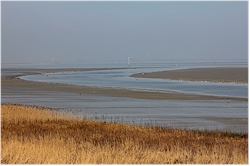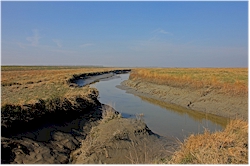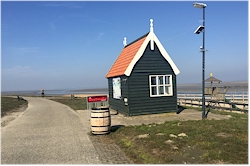|
Picture: walking in the natural reserve |
|
start > > english > europe > netherlands > Saeftinghe |
|
» Saeftinghe visitors center » Emmadorp » Paal
|
Nature reserve "the Drowned Land of
Saeftinghe"
History. The earliest known habitation in the area goes back about 6000 years when the sea level was lower than it is now. About a 1000 years ago the water level was more or less the same as now and shepherds came to settle here. They retreated to the higher parts when it was necessary as protection against high water. After them, monks of the Flemish monasteries came to clear the wastelands and to make them suitable for agriculture. In that period, the village of Saeftinghe was founded. It must have been a quite prosperous community that made a living out of peat digging, salt trade and agriculture. There even appeared to have been a castle. During the 80 Years War (1568 - 1648), the dikes were pierced to flood the countryside to protect Antwerp. Large parts of the area were inundated and people had no other choice than to abandon Saeftinghe. After the war, the flooded lands were gradually recovered but not all of it. The so-called "Drowned Land of Saeftinghe" was one of those areas that were not regained from the sea. Somewhere under the soil of the marshlands there still should be the traces of the lost village...
Visitors center. The visitors center of the reserve is located in the village of Emmadorp. From here you can enter the reserve itself. There are toilets, changing and washing rooms. There is a parking but it is not very big. How to get to Saeftinghe? It's best to go there by own transport. If you come by car, then you can park at the visitors center. The only entrance to the reserve is in Emmadorp. The flat polderlands are ideal for bicycle tours.
Links.
Picture 1: A curlew at the
water line
|
» How to get to Saeftinghe? » Map of sights » links » Clinge » Graauw » Heikant » Hengstdijk » Hulst » Kapellendijk » Kloosterzande » Kuitaart » Lamswaarde » Nieuw-Namen » Ossenisse » Sint-Janssteen » Terhole » Vogelwaarde » Walsoorden
|
|
©
xplorengo.com. No information or pictures can be copied or distributed in any way
without written permission of xplorengo.com.
|

 General.
General.
 Hiking
in Saeftinghe.
Hiking
in Saeftinghe.
 Preparation:
Preparation:
